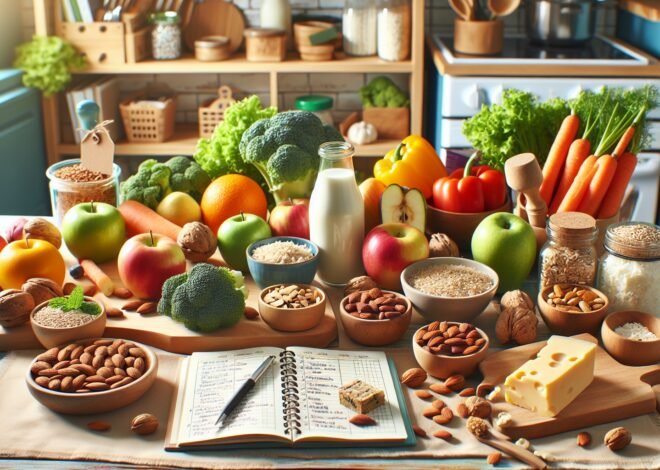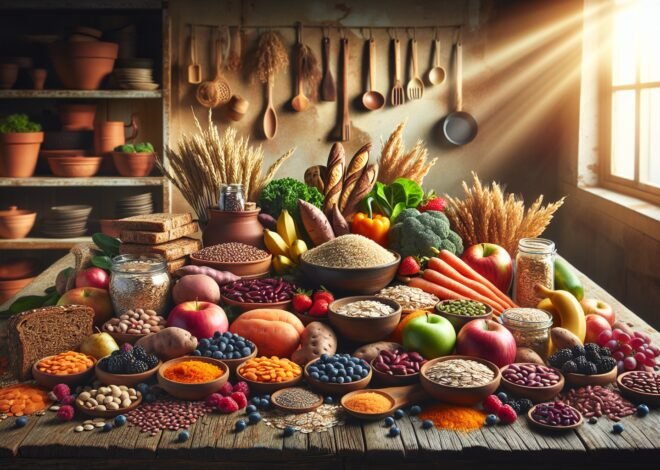
How to Use Garlic and Onions as Anti-Inflammatory Foods
Garlic and onions for inflammation are powerful natural remedies that have been used for centuries to combat pain and swelling. Packed with anti-inflammatory compounds like allicin and sulfur, these common kitchen ingredients can help alleviate symptoms associated with inflammatory conditions. This post will explore the science behind their anti-inflammatory properties, practical ways to incorporate them into your diet, and tips for maximizing benefits. By understanding their healing potential, you can take control of your health and reduce inflammation naturally. Discover how these simple foods can play a significant role in improving your overall well-being.
Understanding the Anti-Inflammatory Properties of Garlic and Onions
Garlic and onions are more than just culinary staples. They pack a powerful punch against inflammation. The unique compounds in these vegetables offer exceptional health benefits. Let’s explore what makes them so special.
Chemical Compounds in Garlic and Onions That Reduce Inflammation
Garlic and onions contain a variety of chemical compounds that actively combat inflammation. In garlic, allicin is the standout anti-inflammatory agent. This compound forms when garlic is chopped or crushed, activating its powerful properties. Allicin helps reduce inflammation by inhibiting enzymes that trigger inflammatory processes. Additionally, garlic also contains sulfur compounds that promote overall wellness.
Onions, on the other hand, are rich in quercetin. Quercetin is a flavonoid with potent anti-inflammatory effects. It works by neutralizing free radicals in the body, reducing oxidative stress, and lowering inflammatory markers. Onions also contain sulfur compounds similar to garlic, which further enhance their anti-inflammatory potential.
Both garlic and onions are rich in antioxidants, which play a crucial role in fighting inflammation. These antioxidants protect cells from damage and reduce the risk of chronic diseases. By incorporating these vegetables into your diet, you can harness the power of these compounds to support a healthier lifestyle.
Health Benefits Beyond Inflammation: Other Ways Garlic and Onions Aid Wellness
While garlic and onions are celebrated for their anti-inflammatory properties, their benefits extend beyond inflammation. These vegetables contribute to heart health by reducing cholesterol levels and improving blood circulation. Garlic, in particular, is known for its ability to lower blood pressure, thanks to its sulfur compounds.
Garlic and onions also boost the immune system. They provide essential vitamins and minerals that support immune function and help the body fight infections. Garlic’s antimicrobial properties can ward off colds and flu, while onions contribute vitamin C, crucial for immune health.
Moreover, these vegetables may help prevent certain types of cancer. Studies suggest that the sulfur compounds in garlic and onions can inhibit cancer cell growth and reduce tumor formation. They are particularly effective against stomach and colorectal cancers.
Incorporating garlic and onions into your diet can also aid digestion. They promote the growth of beneficial gut bacteria, leading to improved digestive health and nutrient absorption. These vegetables’ prebiotic properties make them a valuable addition to a balanced diet.
Comparing the Anti-Inflammatory Effects of Garlic vs. Onions
While garlic and onions both offer anti-inflammatory benefits, their effects differ slightly. Garlic’s high allicin content gives it a slight edge in reducing inflammation. This compound acts quickly and efficiently, providing a robust response to inflammatory triggers.
Onions, however, offer a different approach. Their quercetin content provides a steady, long-term anti-inflammatory effect. This makes onions particularly beneficial for chronic inflammatory conditions, where consistent support is essential.
The best approach is to include both garlic and onions in your diet. This way, you can benefit from their complementary effects. Garlic provides an immediate response, while onions offer sustained support. Together, they create a powerful synergy that enhances your overall health.
Methods to Include Garlic and Onions in Your Daily Diet
Incorporating garlic and onions into your meals is easier than you think. Their versatility allows them to blend seamlessly into a variety of dishes, adding flavor and health benefits. Let’s discover some delicious ways to enjoy these powerhouse vegetables.
Simple Recipes Featuring Garlic and Onions for Anti-Inflammatory Benefits
Creating meals with garlic and onions can be both simple and delicious. Here are some recipes to inspire your culinary journey:
1. Garlic and Onion Stir-Fry:
- Ingredients: Garlic, onions, bell peppers, broccoli, soy sauce, ginger.
- Directions: Sauté garlic and onions in olive oil, add veggies, and stir-fry with soy sauce and ginger.
2. Roasted Garlic and Onion Soup:
- Ingredients: Garlic bulbs, onions, vegetable broth, thyme, olive oil.
- Directions: Roast garlic and onions, blend with broth, season with thyme, and simmer until flavors meld.
3. Garlic and Onion Pasta:
- Ingredients: Whole wheat pasta, garlic, onions, cherry tomatoes, spinach, parmesan cheese.
- Directions: Sauté garlic and onions, add tomatoes and spinach, toss with cooked pasta, sprinkle parmesan.
These recipes not only taste great but also deliver the anti-inflammatory benefits of garlic and onions, making them a smart addition to your weekly meal plan.
How to Prepare Garlic and Onions for Maximum Nutrient Retention
Proper preparation is key to retaining the nutrients in garlic and onions. Here are some tips to ensure you get the most out of these vegetables:
- Chop and Rest: Chop or crush garlic and onions and let them sit for 10 minutes before cooking. This enhances the formation of beneficial compounds like allicin.
- Cook Lightly: Avoid overcooking to preserve nutrients. Aim for a quick sauté or a light roasting to keep their health benefits intact.
- Use Fresh Produce: Fresh garlic and onions contain more active compounds than their processed counterparts. Choose whole, unprocessed vegetables whenever possible.
Following these guidelines will help you retain the maximum amount of nutrients, allowing you to reap the full health benefits of garlic and onions.
Creative Ways to Add Garlic and Onions to Your Meals
There are countless ways to incorporate garlic and onions into your meals without them feeling repetitive. Here are some creative ideas:
- Infused Oils: Create garlic or onion-infused olive oil for drizzling over salads or pasta.
- Savory Bakes: Add chopped garlic and onions to breads or muffins for a savory twist.
- Flavorful Marinades: Use minced garlic and onions in marinades for meats or tofu to add depth of flavor.
Experimenting with different cooking methods can elevate your dishes and ensure you’re getting the health benefits of garlic and onions in every meal.
Potential Side Effects and Considerations When Using Garlic and Onions
While garlic and onions are beneficial, it’s important to be aware of potential side effects. Understanding these can help you enjoy them responsibly and safely.
Understanding Allergic Reactions to Garlic and Onions
Although rare, some individuals may experience allergic reactions to garlic and onions. Symptoms can range from mild to severe and may include:
- Skin Reactions: Rashes or itching after handling or consuming these vegetables.
- Digestive Issues: Bloating, gas, or stomach discomfort.
- Respiratory Symptoms: Sneezing, runny nose, or asthma-like symptoms.
If you suspect an allergy, consult a healthcare professional for proper diagnosis and management. Avoiding these vegetables may be necessary if allergic reactions occur.
Identifying the Best Portions: How Much Garlic and Onions to Consume Daily
Moderation is essential when consuming garlic and onions. While they offer health benefits, excessive intake may lead to unpleasant side effects like:
- Digestive Upset: Large quantities can cause bloating or gas.
- Bad Breath: High consumption may result in persistent garlic breath.
For most people, incorporating a few cloves of garlic or half an onion into daily meals is sufficient. This provides health benefits without overwhelming the digestive system or causing social discomfort.
Consulting Healthcare Providers About Garlic and Onion Intake
If you have underlying health issues or are taking medication, consulting a healthcare provider before increasing garlic and onion intake is wise. These vegetables may interact with certain medications or affect medical conditions.
Healthcare providers can offer personalized advice, ensuring that garlic and onions complement your health regimen without adverse effects. This approach allows you to enjoy the benefits while minimizing risks to your well-being.
Conclusion
Garlic and onions contain compounds with anti-inflammatory properties. They are rich in antioxidants and sulfur-containing compounds, which help reduce inflammation. Research indicates that garlic can inhibit the production of pro-inflammatory substances. Onions have quercetin, a flavonoid that further helps in reducing inflammation. Both vegetables can support overall health by minimizing chronic inflammation.
FAQ
How do garlic and onions help reduce inflammation?
Garlic and onions contain antioxidants and compounds that combat inflammation. They inhibit enzymes responsible for inflammation and reduce oxidative stress, promoting overall anti-inflammatory effects.
Are there specific compounds in garlic and onions that fight inflammation?
Yes, garlic contains allicin, a compound known for its anti-inflammatory properties. Onions have quercetin, a powerful antioxidant that helps reduce inflammation and boosts the immune system.
Can eating raw garlic or onions provide better anti-inflammatory benefits?
Raw garlic and onions may offer stronger anti-inflammatory benefits as cooking can diminish some active compounds. However, they can still be beneficial when cooked, so balance raw and cooked forms in your diet.
What are the best ways to incorporate garlic and onions into my diet for inflammation relief?
Add chopped garlic and onions to salads, soups, and stir-fries. Use them as seasoning in marinades or roast them with vegetables. Their versatility makes it easy to include them in various dishes.
How much garlic and onion should be consumed daily for anti-inflammatory effects?
Consuming 1-2 cloves of garlic and half an onion daily can provide anti-inflammatory benefits. Adjust amounts based on tolerance and dietary needs, consulting a healthcare professional if necessary.
Are there any side effects of using garlic and onions for inflammation reduction?
While generally safe, excessive consumption may cause digestive discomfort, heartburn, or allergic reactions in some individuals. Moderation is key, and those on medication should consult a doctor.











